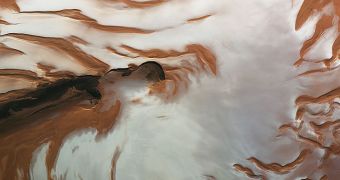Officials with the European Space Agency (ESA) announce that the Mars Express orbiter has recently sent back a new set of images, which are centered on parts of the Red Planet's northern hemisphere. The photos were snapped precisely during the summer solstice on our neighboring planet.
Some of them cover the planetary north pole, an area that experts find very interesting. The NASA Phoenix Mars Lander is the spacecraft that landed the closest to the Martian north pole, and it was able to confirm the existence of ice hidden just beneath a few inches of sand.
In the new images Mars Express collected, geologists indicate that all the frozen carbon dioxide (dry ice) at the location has disappeared, leaving behind only water-ice. This area would make an excellent destination for an exobiology mission sent to the planet.
The High-Resolution Stereo Camera (HRSC) instrument was used to collect the new data, the ESA team reports. The images themselves were collected on May 17, 2010, as the Red Planet was passing through its summer solstice. On Earth, the event takes place on June 22.
“The ice shield is covered by frozen water and carbon dioxide ice in winter and spring but by this point in the Martian year all of the carbon dioxide ice has warmed and evaporated into the planet’s atmosphere,” ESA scientists say in a press release.
They add that the bright white regions in these photos represent water-ice, which is precisely the stuff we will need, should we ever decide to set up a research station or a permanent colony on the Red Planet. The chemical can be used for producing air, water, and hydrogen fuel for rockets.
One of the most interesting aspects of the Martian north pole is that it releases large bursts of water vapors into the atmosphere from time to time. The emissions originate between layers of water-ice, and at this point researchers have no idea how they are produced.
“The polar ice follows the seasons. In winter, part of the atmosphere recondenses as frost and snow on the northern cap. These seasonal deposits can extend as far south as 45°N latitude and be up to a meter thick,” the ESA statement reads.
According to the agency, Mars Express will have another excellent chance to image the shape, depth and composition of the ice sheet this month, and then again in September. ESA experts will undoubtedly be training the spacecraft on the north pole again during these two months.
Given the recent discoveries made on Mars – such as the fact that primitive life may be possible and that seasonal water flows may still occur on the surface – the new investigations session will take on new meanings.

 14 DAY TRIAL //
14 DAY TRIAL //